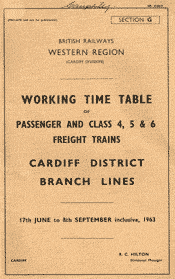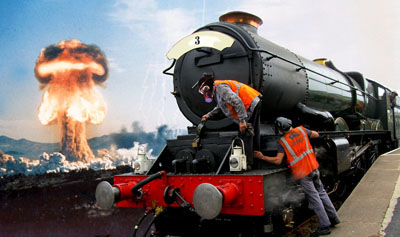
![]()

Trains and Railway Miscellany
South Wales Railways 1930's
Looking more like a road map, this view of the south Wales valley lines dates back to the 1930's. The map shows the incredible density of lines needed to serve the coalfield and the north-south layout which took the black stuff to the main coal-exporting ports at Cardiff, Newport, Barry and Penarth.
This was the Saudi Arabia of its day with millions of tons of coal dug up every year, making fortunes for the mine owners and shippers. In 1913, over 10 million tons of coal were exported from Cardiff alone.
The map shows the Great Western Railway network in red - the thin black lines show the LMS routes into Wales. The LMS heads of the valleys line ran from Abergavenny (just off the top right of the map) into Merthyr with branches to Nine-mile point, Ebbw Vale and Abersychan. Before the 1923 railway grouping which formed the GWR as shown in the map, there were four major railway companies operating in south Wales -The Barry, Rhymney, Taff Vale and Great Western Railways.
South Wales Railways 1930's

South Wales Railways 1960's
Moving forward thirty something years and this simplified schematic of south Wales railways gives an idea of how the network looked in the early 1960's. The Beeching cuts are still to come, the miners strike is 20 years in the future and every valley still has its heavy industry; collieries, coke works and steelworks.
South Wales Railways 1960's

The main east-west south Wales main line appears as 'section F'. Lines that are still open today are shown in red.
The decline of industry in the valleys means that almost all rail traffic north of Cardiff is passenger with the exception of coal trains from Hirwaun to Aberthaw power station west of Barry.
More positively, passenger numbers have increased year-on-year with formerly 'freight only' lines such as the City line between Radyr and Leckwith Loop Jn and the Vale of Glamorgan line between Barry and Bridgend gaining new stations and opening to passenger trains.
 Work
as a Film Extra - You
can earn £80-140 a day and
more working
as a film or tv extra or background performer/artist.
Work
as a Film Extra - You
can earn £80-140 a day and
more working
as a film or tv extra or background performer/artist.
Extra payments for using firearms, wearing uniform etc. It's not as glamorous as it sounds and you're unlikely to get rich but it can make for an interesting couple of days and you might get to see your favourite stars up close.
Many re-enactors of everything from the Civil War to World War 2 have appeared in films.
You'll need to supply good quality head and shoulders and full-length photographs, a short CV plus full details of height, weight, and all your clothes sizes.
Find out more about working as a film extra

The Strategic Steam Reserve - Myth or Reality?
Lines of dusty steam engines stored and ready for use after the apocalypse! Find out about the hundreds of UK steam locomotives kept in storage since the sixties in case the Nuclear balloon went up. After the Soviet ICBM's had finished dropping their estimated total of 2000 Megatons TNT equivalent, a battered but uncowed Britain could emerge victorious from the fallout in the shape of Thomas the tank engine pulling a trainload of ministry of supply corned beef...

|
|
 |

